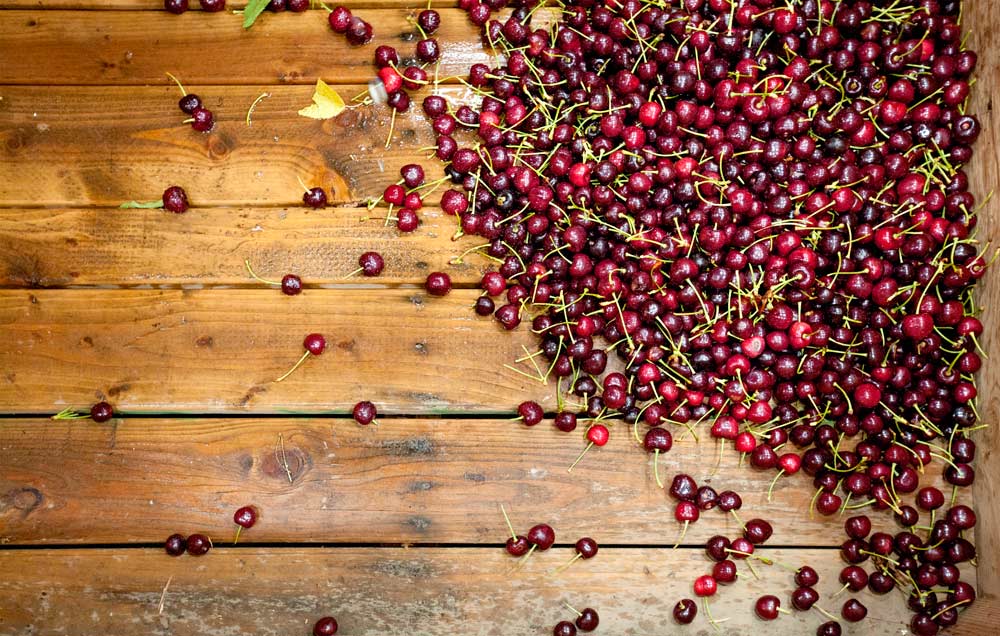
Advancements in postharvest practices aim to reduce waste, such as these culled cherries — many with near imperceptible damage to the untrained eye — which end up in a bin at a Yakima, Washington, packing house. (TJ Mullinax/Good Fruit Grower)
Forty percent of all the food produced in the U.S. is wasted — culled because it didn’t meet quality standards in the field or developed a disorder during storage or because it went unsold in stores or uneaten by consumers. For fresh fruits and vegetables, the picture worsens.
More of the $65 billion a year in food waste happens at the consumer level than on farms or in packing houses, but postharvest practices still have an opportunity and responsibility to improve, said Rob Blakey, a postharvest researcher for Wenatchee, Washington-based Stemilt Growers.
“Why do consumers waste food? Perhaps it just doesn’t taste good,” he mused at the opening session of the Washington State University Postharvest Fruit School in March. “Why do we need to improve? There is global food insecurity and malnutrition and the global population is expected to peak at 11 billion.”
Reducing wasted fruit saves environmental and financial resources, and increasing packouts will be key to ensuring fruit production stays profitable for growers.
That’s why this year the Fruit School opted to focus on the fundamentals and exciting new advancements in postharvest science for apples, cherries, pears and berries.
The tools are quite different for climactic fruit such as apples and pears, which continue to ripen in carefully controlled storage, and nonclimactic fruit such as cherries and berries, which have to be picked ripe and handled with care, said Ines Hanrahan, research manager for the Washington Tree Fruit Research Commission, but the goals are the same: preserve health and quality of fruit until the consumer has a chance to eat it.
The theme on the first day of the three-day training was that better collaboration between the orchard and the packing house can improve postharvest practices and packouts.
“All of us have one overarching goal, which is to put the highest quality fruit on the retail shelves that we can,” said Bill Wolk, quality development manager for the B.C. Tree Fruits Cooperative in British Columbia, Canada. “The quality on the shelf is created in the orchard, not in the CA storage or packing line. CA storage is to minimize that loss of quality.”
Thanks to new tools and research, postharvest science is improving its ability to tailor storage conditions to fruit needs. It’s important to remember that harvested fruit is still alive, and it can talk to you if you know how to listen, Hanrahan said.
Tracking respiration for warnings of fruit stress; assessing quality and maturity through dry matter, sugars, acidity or firmness; using new metabolic tests to predict disorders in advance; and an overall better understanding of how growing season conditions affect storage needs for different varieties will all help improve packouts in the future, speakers at the Fruit School said. But Blakey insisted that the most important part of postharvest work was not forgetting about the fundamentals in light of emerging technology.
“If we don’t have our foundations right, it’s a house built on sand,” he said. “We have to manage the fruit we’ve got right, and we have to manage the atmosphere, with temperature, that’s paramount. We have to manage the cold chain and store fruit at the right temperature, and we have to manage oxygen and CO2. We have to manage ethylene, and a big part of that using 1-MCP, and we have to manage air flow to have a more uniform atmosphere in our CA rooms and our ripening rooms, and we have to manage humidity.”
But people represent the most important tool of all, Hanrahan and Blakey agreed. Up and down the value chain, from in-orchard nutrition to marketing decisions about when to open a storeroom, better collaboration will result in improvements to fruit quality, they said.
“We need to get the right fruit in the right room at the right time,” said Jake Gutzwiler, Stemilt’s quality control manager. “Success in storage is being invisible, because all you can do is maintain the integrity of what you have. But quite often, fruit movement does not exceed maturity and ripening, and that is when the challenge comes.”
Packing houses need to know as much as possible about the fruit they are receiving, he said. “We need to know if 50 percent of our fruit can’t last past December.”
Quality and maturity assessment tools fill this gap, although some are more grower friendly than others.
“Everyone is already using harvest maturity to allocate fruit into CA,” Wolk said, but he advocates using dry matter as well as an additional link between orchard and postharvest management. “High dry matter fruit is well grown fruit; you don’t arrive at high dry matter fruit by luck or accident.”
Dry matter indicates quality, not maturity, and predicts high sugars and acids coming out of storage. Wolk also recommends growers assess firmness at harvest to predict firmness coming out of storage.
“The bigger the fruit, the better the correlation. Which tells me that on the fruit that makes you the most money, it works the best, so that’s a good thing,” he said.
All those quality measures ensure fewer surprises as fruit comes out of storage — good news for everyone, since storage mistakes are expensive ones.
“This time of year, I feel like I’m a fruit detective,” Gutzwiler said. “If there’s a murder, I have to go find out what happened, but it’s too late.” •
—by Kate Prengaman






Leave A Comment